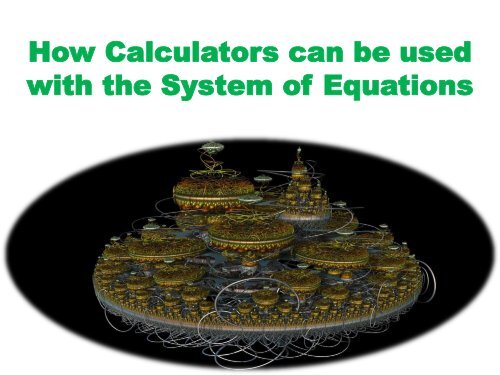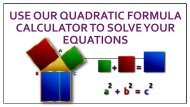How Calculators can be used with the System of Equations
Math is quite an intimidating subject. Each new topic throws out several symbols, formula and logical reasoning which could throw you out quite literately. However, practice and logical reasoning are the two things that can help you in this field. You have to take it step by step right from the basics and take it from there.
Math is quite an intimidating subject. Each new topic throws out several symbols, formula and logical reasoning which could throw you out quite literately. However, practice and logical reasoning are the two things that can help you in this field. You have to take it step by step right from the basics and take it from there.
Create successful ePaper yourself
Turn your PDF publications into a flip-book with our unique Google optimized e-Paper software.
<strong>How</strong> <strong>Calculators</strong> <strong>can</strong> <strong>be</strong> <strong>used</strong><br />
<strong>with</strong> <strong>the</strong> <strong>System</strong> <strong>of</strong> <strong>Equations</strong>
Now, <strong>the</strong>re are times when time or complicity <strong>of</strong><br />
calculations makes it even harder. This is where<br />
online calculators or math solvers come in. With<br />
<strong>the</strong> advance <strong>of</strong> technology, such math solvers<br />
have <strong>be</strong>come increasingly popular and useful.
They’re<br />
especially<br />
handy when you<br />
are short <strong>of</strong> time<br />
and need fast<br />
answers, or<br />
when such<br />
calculations are<br />
just a part <strong>of</strong><br />
ano<strong>the</strong>r lengthy<br />
process.
One such solver is <strong>the</strong> system <strong>of</strong> equations calculator.<br />
There are several sites where you <strong>can</strong> find such fast<br />
working solvers like say MathPapa or WebMath. These<br />
solvers are pretty much self-explanatory, and <strong>the</strong>se<br />
sites usually have demos and examples which you<br />
could go through <strong>be</strong>fore starting your own calculations.
In <strong>the</strong> system <strong>of</strong><br />
equations<br />
calculator, you<br />
need to input <strong>the</strong><br />
equations<br />
separated by<br />
commas. For<br />
example, let us<br />
take two simple<br />
equations -<br />
x + y = 10 and x +<br />
2y = 16.
You will need to<br />
input <strong>the</strong>se two<br />
equations in <strong>the</strong><br />
box given to you,<br />
separated <strong>with</strong><br />
commas like<br />
x + y = 10, x + 2y<br />
= 16. Once you<br />
press <strong>the</strong> button to<br />
calculate it, it will<br />
give you <strong>the</strong><br />
answer <strong>of</strong> x = 4<br />
and y = 6.
These are quite simple equations that we have<br />
taken as examples. These solvers <strong>can</strong> handle<br />
more complicated ones too. The <strong>be</strong>st part is that<br />
such calculators also give you a step by step<br />
explanation. Thus you <strong>can</strong> check <strong>the</strong> answers<br />
and understand <strong>the</strong> process <strong>be</strong>tter.
• The system for<br />
equations<br />
calculator <strong>can</strong><br />
<strong>be</strong> <strong>used</strong> to solve<br />
expressions and<br />
also for double<br />
checking<br />
answers for<br />
equations<br />
having x.<br />
Checking answers
For example,<br />
let’s say we<br />
solved an<br />
equation 3x + 2<br />
= 8 and we got<br />
an answer <strong>of</strong> x<br />
= 2. You <strong>can</strong><br />
input 2 in <strong>the</strong><br />
original<br />
equation 3x + 2<br />
= 8 @ 2 and<br />
check <strong>the</strong> work.
If <strong>the</strong> answer is<br />
correct, <strong>the</strong>n <strong>the</strong><br />
calculator like<br />
MathPapa would<br />
show an equal<br />
green sign. If you<br />
input a wrong<br />
answer, it would<br />
give you just <strong>the</strong><br />
opposite and<br />
show you an<br />
equal red sign.
The same <strong>can</strong> also<br />
<strong>be</strong> <strong>used</strong> to<br />
determine<br />
equations are<br />
having x as well as<br />
y. All you need to<br />
do is enter both <strong>the</strong><br />
equations which<br />
would <strong>be</strong><br />
separated by<br />
semicolon and<br />
should <strong>be</strong> followed<br />
by @.
For example,<br />
x + y = 10; x +<br />
2y = 16 @ (4,<br />
6).<br />
Every<br />
s<strong>of</strong>tware<br />
would have<br />
slightly<br />
different<br />
features and<br />
is mostly<br />
compatible<br />
<strong>with</strong> all<br />
devices.
In some calculators like MathPortal, you have a choice<br />
wherein you <strong>can</strong> choose <strong>the</strong> way <strong>of</strong> solving your<br />
equations. That is you <strong>can</strong> opt to use <strong>the</strong> default<br />
method <strong>of</strong> addition or elimination or <strong>the</strong> method<br />
followed by Cramer’s rule and also determine whe<strong>the</strong>r<br />
you want to see <strong>the</strong> steps or just get <strong>the</strong> answer.<br />
Learn More:<br />
https://quickmath.com/webMa<strong>the</strong>matica3/quickmath/equations/solve/basic.jsp


















